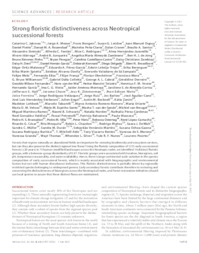Strong floristic distinctiveness across Neotropical successional forests.
Strong floristic distinctiveness across Neotropical successional forests.
Author(s): JAKOVAC, C. C.; MEAVE, J. A.; BONGERS, F.; LETCHER, S. G.; DUPUY, J. M.; PIOTTO, D.; ROZENDAAL, D. M. A.; PEÑA-CLAROS, M.; CRAVEN, D.; SANTOS, B. A.; SIMINSKI, A.; FANTINI, A. C.; RODRIGUES, A. C.; HERNÁNDEZ-JARAMILLO, A.; IDÁRRAGA, A.; JUNQUEIRA, A. B.; ZAMBRANO, A. M. A.; JONG, B. H. J. de; PINHO, B. X.; FINEGAN, B.; CASTELLANO-CASTRO, C.; ZAMBIAZI, D. C.; DENT, D. H.; GARCÍA, D. H.; KENNARD, D.; DELGADO, D.; BROADBENT, E. N.; ORTIZ-MALAVASSI, E.; PÉREZ-GARCÍA, E. A.; LEBRIJA-TREJOS, E.; BERENGUER, E.; MARÍN-SPIOTTA, E.; ALVAREZ-DAVILA, E.; SAMPAIO, E. V. de S.; MELO, F.; ELIAS, F.; FRANÇA, F.; OBERLEITNER, F.; MORA, F.; WILLIAMSON, G. B.; COLLETTA, G. D.; CABRAL, G. A. L.; DERROIRE, G.; FERNANDES, G. W.; WAL, H. van der; TEIXEIRA, H. M.; VESTER, H. F. M.; GARCÍA, H.; VIEIRA, I. C. G.; JIMÉNEZ-MONTOYA, J.; ALMEIDA-CORTEZ, J. S. de; HALL, J. S.; CHAVE, J.; ZIMMERMAN, J. K.; EDISON NIETO, J.; FERREIRA, J. N.; RODRÍGUEZ-VELÁZQUEZ, J.; RUÍZ, J.; BARLOW, J.; AGUILAR-CANO, J.; HERNÁNDEZ-STEFANONI, J. L.; ENGEL, J.; BECKNELL, J. M.; ZANINI, K.; LOHBECK, M.; TABARELLI, M.; ROMERO-ROMERO, M. A.; URIARTE, M.; VELOSO, M. D. M.; ESPÍRITO-SANTO, M. M.; SANDE, M. T. van der; BREUGEL, M. van; MARTÍNEZ-RAMOS, M.; SCHWARTZ, N. B.; NORDEN, N.; PÉREZ-CÁRDENAS, N.; GONZÁLEZ-VALDIVIA, N.; PETRONELLI, P.; BALVANERA, P.; MASSOCA, P.; BRANCALION, P. H. S.; VILLA, P. M.; HIETZ, P.; OSTERTAG, R.; LÓPEZ-CAMACHO, R.; CÉSAR, R. G.; MESQUITA, R.; CHAZDON, R. L.; MUÑOZ, R.; DeWALT, S. J.; MÜLLER, S. C.; DURÁN, S. M.; MARTINS, S. V.; OCHOA-GAONA, S.; RODRÍGUEZ-BURITICA, S.; AIDE, T. M.; BENTOS, T. V.; MORENO, V. de S.; GRANDA, V.; THOMAS, W.; SILVER, W. L.; NUNES, Y. R. F.; POORTER, L.
Summary: Forests that regrow naturally on abandoned fields are important for restoring biodiversity and ecosystem services, but can they also preserve the distinct regional tree floras? Using the floristic composition of 1215 early successional forests (<20 years) in 75 human-modified landscapes across the Neotropic realm, we identified 14 distinct floristic groups, with a between-group dissimilarity of 0.97. Floristic groups were associated with location, bioregions, soil pH, temperature seasonality, and water availability. Hence, there is large continental-scale variation in the species composition of early successional forests, which is mainly associated with biogeographic and environmental factors but not with human disturbance indicators. This floristic distinctiveness is partially driven by regionally restricted species belonging to widespread genera. Early secondary forests contribute therefore to restoring and conserving the distinctiveness of bioregions across the Neotropical realm, and forest restoration initiatives should use local species to assure that these distinct floras are maintained.
Publication year: 2022
Types of publication: Journal article
Unit: Embrapa Eastern Amazon
Keywords: Biodiversidade, Floresta, Preservação da Natureza
Observation
Some of Embrapa's publications are published as ePub files. To read them, use or download one of the following free software options to your computer or mobile device. Android: Google Play Books; IOS: iBooks; Windows and Linux: Calibre.
Access other publications
Access the Agricultural Research Database (BDPA) to consult Embrapa's full library collection and records.
Visit Embrapa Bookstore to purchase books and other publications sold by Embrapa.

